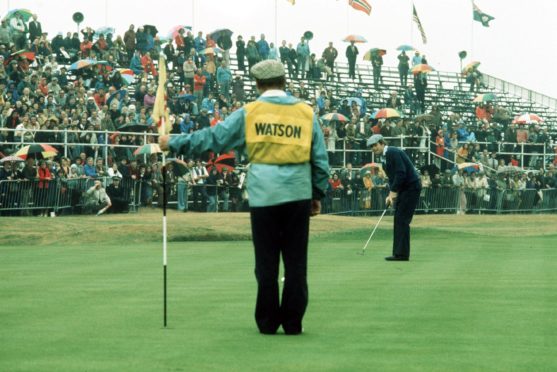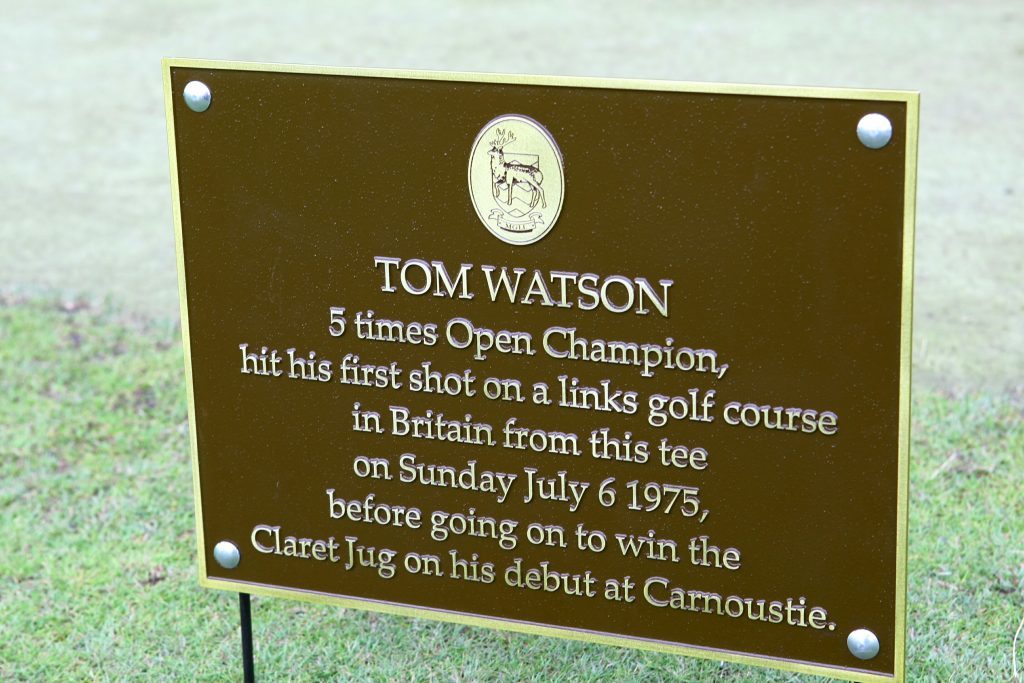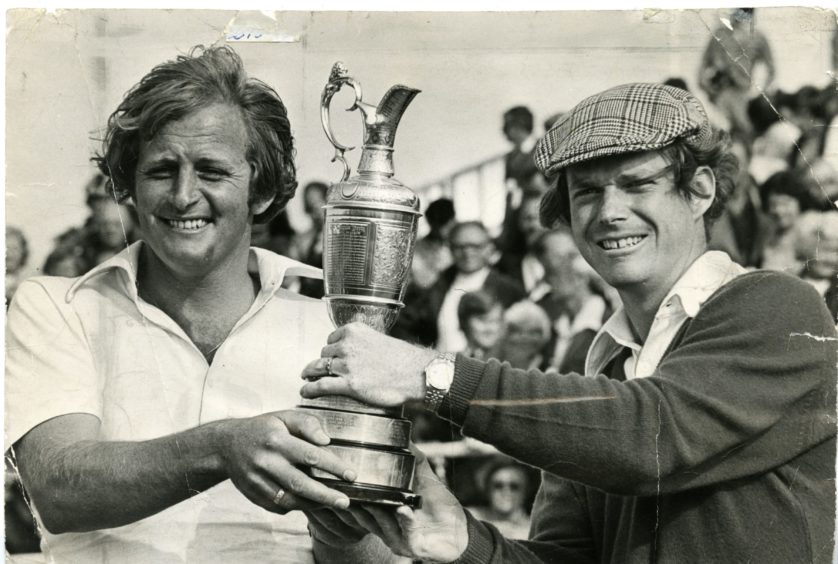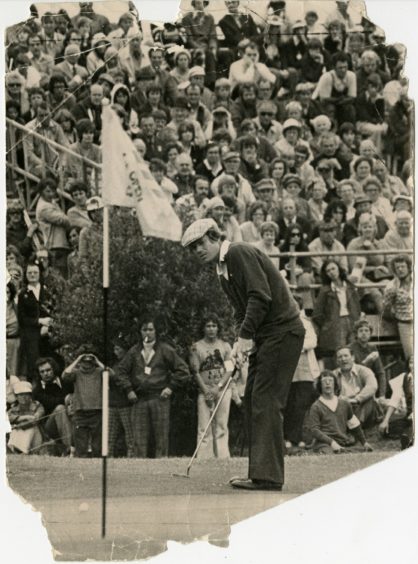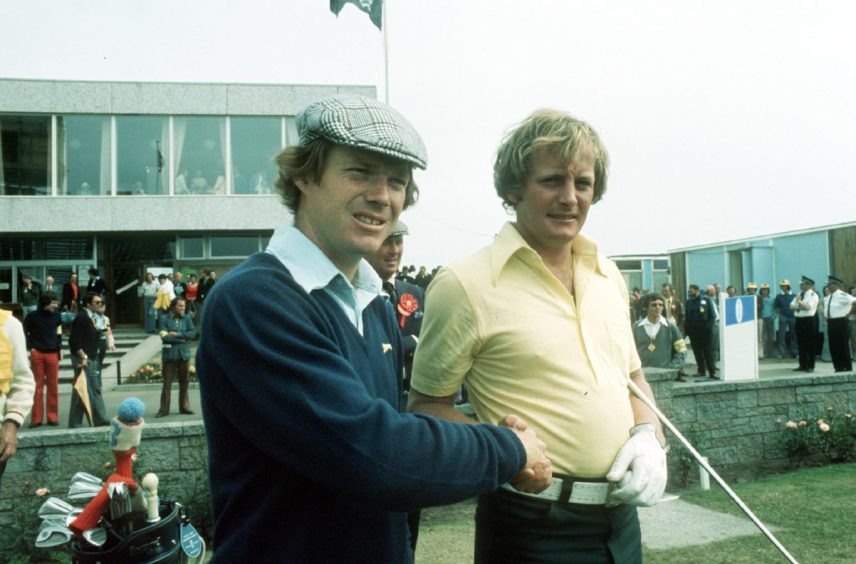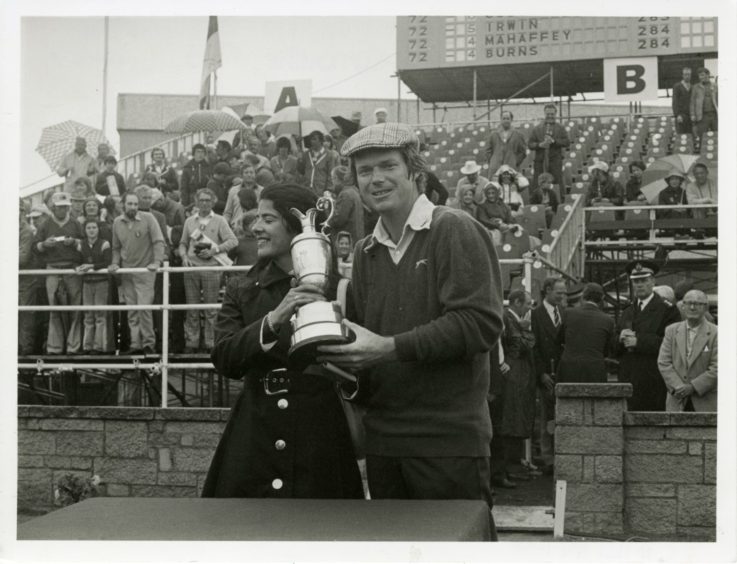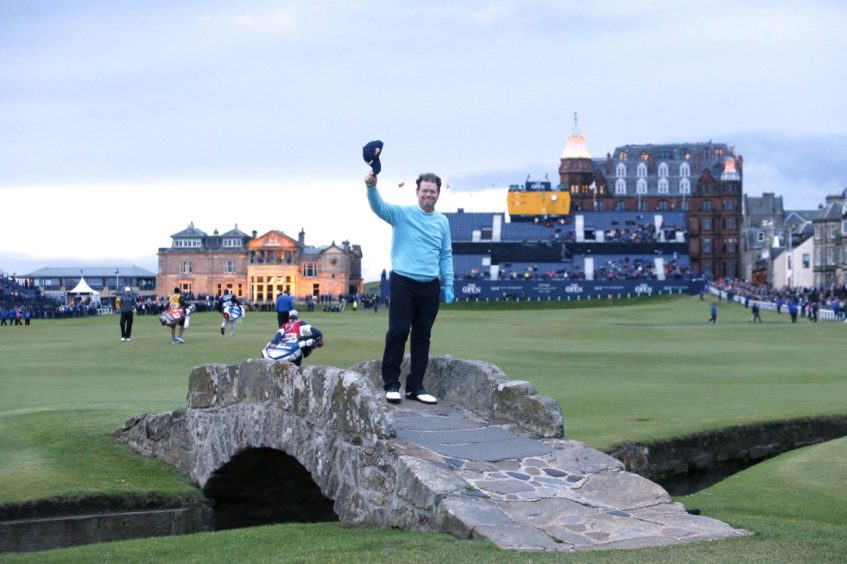It was the Open victory at Carnoustie 45 years ago which started golf legend Tom Watson’s love affair with Scotland.
Watson celebrated in Monifieth after winning the Claret Jug and would keep a good-luck charm from a local girl in his bag for the next few years.
The then 25-year-old got his first taste of links golf at Monifieth Medal after he discovered nearby Carnoustie was closed for practice games ahead of his first Open.
“Monifieth Golf Links was the first one I ever saw, because Keith Mackenzie (the late R&A secretary) didn’t allow myself and John Mahaffey to have a practice round at Carnoustie when we got there in 1975,” he said.
“So we did the next best thing, which was to go to Monifieth.
“I had a local caddie and, at the second or maybe fourth hole, he told me to hit straight down the middle over a hump and I did just that.
“But we couldn’t find the ball.
“I was about ready to give up when we found it in the middle of a pot bunker 30 yards to the right of where I’d hit it, absolutely dead.
“It had obviously hit one of the slopes and ended in there.
“I thought to myself – I don’t like this at all.”
The practice round helped him come to terms with the peculiarities of links golf and he went on to win the Claret Jug after a play-off against Jack Newton from Australia.
Initially it appeared that Carnoustie was about to witness its first no-contest.
Peter Oosterhuis took the first 27 holes of the championship apart in windless weather and was four shots ahead before he took 39 for the back-nine.
After qualifying for the championship in a seven-man play-off, David Huish, the club professional from North Berwick, shot rounds of 67 and 69 to lead by two strokes.
Sharing in the excitement was 13-year-old Carnoustie High School pupil Alan White who was carrying Huish’s bag after being recommended by another tournament caddie.
The course was taken apart in round three when Newton shot 65 to set a new course record and 14 players broke 70 but Scottish club pro went back to the day job with a 76.
Newton was second to Bobby Cole from South Africa, who had won the Amateur Championship on the course as a 16-year-old in 1966.
Johnny Miller was third, while the unnoticed Watson was in fourth.
On the final day, however, the weather turned decisively and the wind came back with a vengeance.
Watson was staying in Monifieth during the week and he received a surprise gift on his way to the course.
“A little girl came up to me in her bare feet on that cold rainy morning and gave me a good luck charm,” Watson said.
“It was a piece of white heather wrapped in aluminium foil.
“I kept it in my golf bag for well over a year.
“It helped my understanding of what golf is in Scotland.
“People embrace it, they respect it.
“They will give you a round of applause that acknowledges how tough it was.
“That is just part of the fabric of life here.”
Jack Nicklaus carded par to set a 280 target with six men still out on the course.
Watson went round in 72 despite a fourth bogey in four tries at the 16th which was enough to leave him champion-elect.
Newton toughed out a 74 to make the play-off.
The extra 18 holes were tense rather than thrilling.
Angus schoolboy Ian Gerrard made a surprise impact during the Sunday play-off when he mistakenly picked up a golf ball that was still in play.
“I remember the ball coming across and landing at my feet,” he said.
“So I picked it up.”
He was immediately advised to put it down again where it had fallen but the incident made the newspapers and television the next day.
Although Ian remembers little about the incident, The Courier reported it at the time.
Our golf reporter wrote: “In the tension-packed opening stages, as the crowd swarmed around, a small boy picked up Jack Newton’s ball just off the second fairway.
“Fortunately he was spotted in the act and the Australian was able to replace it.”
Watson twice opened up a two-stroke lead and twice he was pegged back by his opponent and eventually it came down to the 18th.
Both hit the fairway and both selected a two-iron for their approach shots.
Newton played first and pulled his shot into the greenside bunker while Watson found the heart of the 18th green.
A two-putt par was enough to make Watson the champion following the play-off and he won £7,500 in prize money.
Perth man Alex Harvey was the man responsible for engraving Watson’s name on the championship trophy.
Watson took the trophy back to the house in Monifieth and said it seemed like the whole neighbourhood came by.
“My love affair with the Scottish people had begun,” he said.
1975 was the first of five Open titles for Watson in eight years.
After 40 years, 130 rounds and five Claret Jugs, the great man played his final round in The Open at St Andrews in 2015.
He said: “I’ve had more lucky bounces than I’ve had bad bounces over my career, so I feel grateful to have accomplished what I’ve accomplished, and I hope that I’ve entertained people along the way.
“That’s the thing. I hope that they’ve enjoyed my golf play as I’ve competed over these last 40 years in the Open Championship.
“I hope I’ve hit some shots that they remember.
“Over the years I’ve made my share of wrong decisions, but do I have any regrets?
“The only regret I have is that it’s the end.
“It really is.
“It’s the end.
“It’s 40 years.
“It’s the end. And I regret I don’t have the tools in the toolbox to be able to continue on.”
A legend notable for his longevity at the top
Born in Kansas City, Missouri, in September 1949, Watson was introduced to the game by his father Ray and won four Missouri State Amateur Championships while attending Stanford University, from where he graduated with a degree in psychology.
Despite his knowledge in that field of study, he earned an early reputation as a player who wilted under pressure.
That changed in 1974, three years after he turned pro, when he began working with Byron Nelson, who would become a great friend and mentor.
That year he broke through with his first PGA Tour victory and the following year he won his first Open title at Carnoustie.
It was the start of his eight-majors-in-eight-years heyday and Watson’s dominance might have been even more emphatic.
Several of Watson’s most famous victories came at the expense of his biggest rival Jack Nicklaus, the most notable being the Masters and Open in 1977 and the 1982 US Open.
In April of 1977, Watson held off Nicklaus to win his first green jacket at Augusta.
But it was their meeting at Turnberry that year which is considered a contender for the greatest head-to-head battle the sport has ever seen.
Both shot 65 in the third round to go into the final 18 holes three clear of the field.
After 16 holes the two were tied but Nicklaus missed his birdie putt on 17 while Watson made his.
On the 18th, Nicklaus drove into the rough, while Watson’s approach landed two feet from the flag.
Nicklaus managed to get his approach to 40 feet away before sinking a birdie to finish with a 66.
Watson, though, followed suit with his own birdie, finishing with a second straight 65 and a record score of 268 (12 under par).
The battle was played out under clear blue skies and is remembered forever as the “Duel in the Sun”.
In 1978, as defending Masters champion, he needed a par on the 18th hole of his final round to tie over 72 holes with Player but missed a 10-foot putt.
One of the biggest disappointments of his career came in that year’s US PGA Championship at Oakmont.
Watson had a five-shot lead after 54 holes, but lost the tournament in a three-way sudden-death play-off to John Mahaffey.
He would never come closer to landing the one major title that eluded him.
In 1979, Watson again finished runner-up at the Masters, this time losing in another three-way play-off to Fuzzy Zoeller.
Watson had an outstanding year in 1980.
A brilliant third round of 64 at Muirfield helped him to win his third Open Championship by four strokes.
In 1981, he won his second Masters title, beating Nicklaus and Johnny Miller by two strokes, but the US Open was the tournament that Watson most wanted to win.
He did it the following year, winning another engaging duel with Nicklaus in one of the most memorable major championships of all time.
The following month at Royal Troon, Watson became only the third golfer since the Second World War to win the US Open and Open Championship in the same year.
The following July, he won his fifth Open and the last of his eight majors at Royal Birkdale.
He came close to major number nine the following year, finishing runner-up in The Masters and tied second behind Ballesteros at St Andrews in 1984.
Watson is also notable for his longevity.
At 59, and 26 years after his last major championship victory, he led after the second and third rounds of The Open in 2009.
With a chance to win the tournament with par on the 72nd hole, he missed an eight-foot putt and took a bogey.
He then lost to Stewart Cink in the play-off.
He played on four Ryder Cup teams and captained the American side to victory in 1993 at The Belfry.
He went on to win the British Senior Open Championship in 2003, 2005 and 2007.
